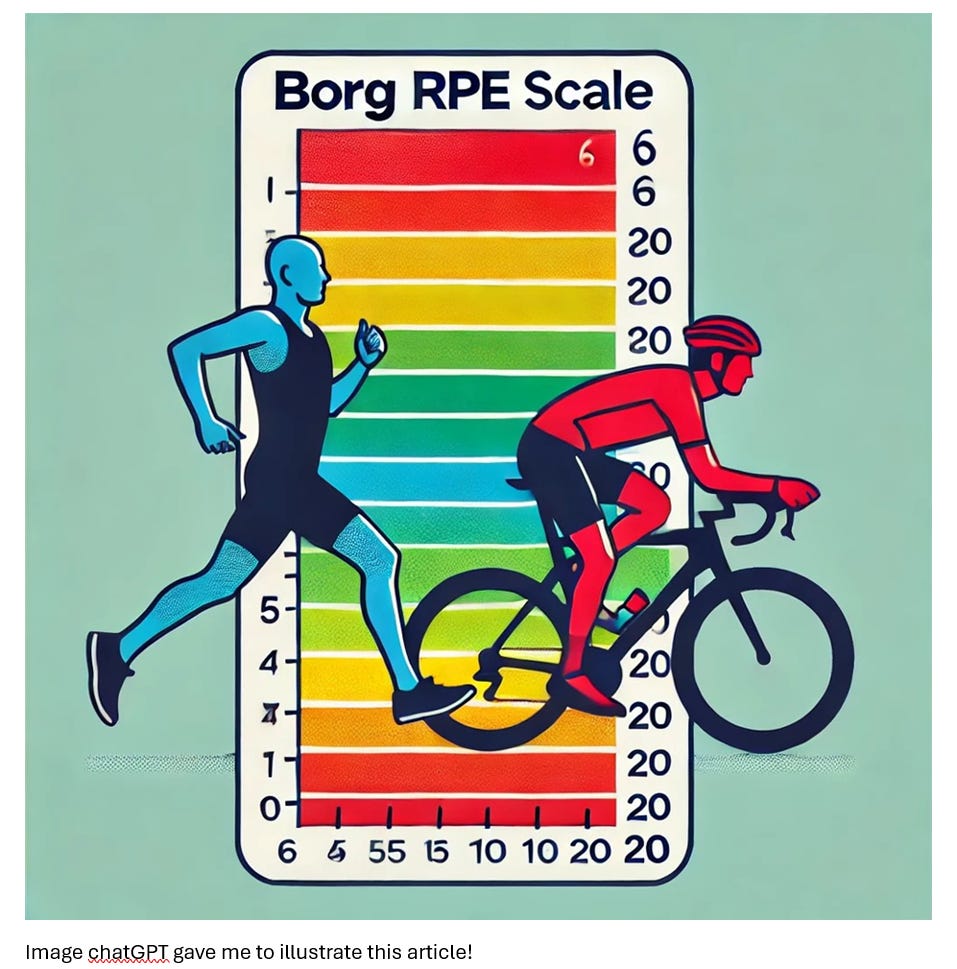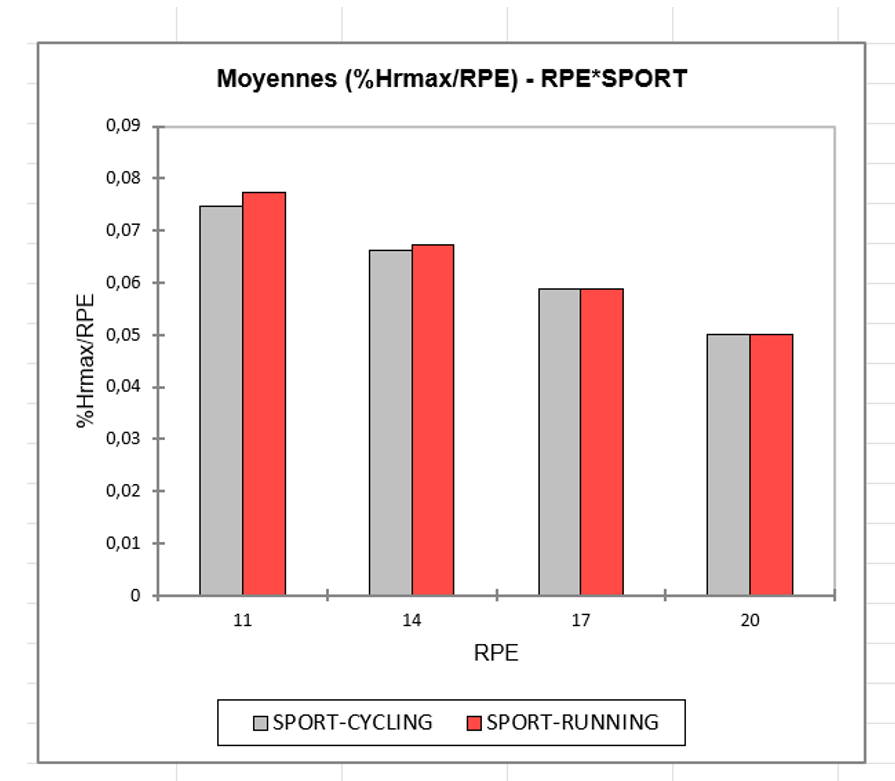To avoid “outgrowing the BORGs” and to trust each other
So that you're not always THE BEST VERSION of yourself!
So, it's definitely worth making the effort to ...read (and yes, you won't even be able to practice Woody Allen's speed-reading method, who claimed to practice it and who summed up the paving stone “War and Peace” by declaring that this book was about ...War and Peace!).
In physiology, facts are stubborn. Let's continue our reflection on the data from Julien, a triathlete with a predominantly cycling background, concerning the reliability and transferability of his cycling and running sensations in relation to the maximum values of his cardiorespiratory and power and cadence variables.
Table 1 shows the physiological variables recorded at each level of perceived effort intensity on the Borg Figure 1 scale (11 = Easy, 14 = Medium; 17 = Hard) expressed as a percentage of their maximum values, divided by the Rating of Perceived Exertion (RPE) scale. Here's an explanation of the main variables and their significance:
Physiological variables
1. %Hrmax/RPE :
Percentage of maximum heart rate related to perceived exertion.
- Hrmax: maximum heart rate, an indicator of cardiovascular effort.
This indicator shows how the heart rate perceived by the subject varies as a function of effort.
2. %PETCO2max/RPE :
Percentage of maximal partial pressure of exhaled carbon dioxide (PETCO2) in relation to RPE.
- A marker of ventilatory efficiency and CO2 elimination.
- Linked to ventilatory threshold, showing metabolic compensation capacity.
3. Rf%max/RPE :
Ratio of maximum respiratory rate (Rf) to RPE.
- Measures perceived respiratory rate in relation to effort.
4. Vt%max/RPE :
Ratio of maximum tidal volume (Vt) to RPE.
- Indicates the amount of air mobilized with each breath in relation to perceived effort.
5. VI%max/RPE :
Maximum inspiratory volume to RPE.
- Measures lung ventilation capacity during perceived effort.
6. VE/VO2%max/RPE :
Minute ventilation per liter of oxygen consumed (VE/VO2) referred to RPE.
- Measures ventilatory efficiency for oxygen delivery.
7. VE/VCO2%max/RPE :
Minute ventilation per liter of CO2 produced (VE/VCO2) referred to RPE.
- Indicates respiratory control and CO2 tolerance.
8. VO2 ml/minkg %VO2max/RPE:
Oxygen consumption relative to VO2max, adjusted to perceived exertion.
- Reflects aerobic capacity relative to perceived effort.
9. VCO2 ml/minkg %max/RPE :
CO2 production relative to body weight and RPE.
- Indicates metabolic balance, particularly between energy substrates (carbohydrates/lipids).
10. QR%/RPE :
Respiratory ratio (RQ) between oxygen consumption and CO2 production, relative to RPE.
- Used to estimate which substrate (carbohydrate or lipid) is used as the main source of energy.
11. Cadence %max/RPE :
Cadence (rhythm) of effort expressed as a percentage of maximum cadence divided by RPE.
- Indicates coordination or frequency of movement.
12. Power %PMA (vVO2max)/RPE :
Maximum aerobic power (PMA) or speed associated with VO2max (vVO2max), related to RPE.
- Shows how power attainment is perceived according to effort.
Results analysis
- Means and standard deviations:
- Variables are globally around 5-6% on average with low standard deviations (1-2%), except for some variables like `%PETCO2max/RPE` (more variable).
- This suggests homogeneity in the perception of effort in relation to physiological parameters and to the type of sport (cycling-running).
- Importance of RPE:
- RPE is a subjective scale (generally from 6 to 20 or 0 to 10) used to quantify perceived exertion.
- By dividing each parameter by RPE, we can compare the relative physiological efficiency perceived during effort.
- Key variables :
- Power %PMA/RPE and VO2%max/RPE are essential for assessing aerobic efficiency and work capacity.
- QR%/RPE at zero standard deviation, suggesting perceived metabolic stability.
The percentage of a rung on the Borg scale decreases with effort intensity: when in the “easy” range: from 11 to 14, each rung on the Borg scale is worth 7% of FCmax (8% in the easy range for running).
Then, when you're in the “hard” and “very hard” ranges, each rung on the scale is worth only 5% of HRmax, WHATEVER the sport, indicating that our sensation is refined and remains identical for running and cycling.
However, he has a finer sensation when cycling than when running, for which 1 bar of RPE is still worth 7% of VO2max, but which tends to become clearer as the effort intensifies (4.7% of VO2max). So he still needs to work on his running sensations by following the perception sessions: https://www.deboecksuperieur.com/ouvrage/9782807363199-course-pied-s-entrainer-la-sensation
But Julien can still rely on his sensations, even if he's more of a cyclist than a runner, and the hardest thing for him now is...to trust himself and free himself from the gaze of his watch, his computer and his “gauge of judgment” and self-demand. To cure yourself of always wanting to be the “best version” of yourself, I recommend watching the film “The Substance”. Sensitive souls please!
Listen whet he said himself in one mail he sent me:
Hello Véronique,
Very interesting, the comparison of the two is almost what I felt. At the end of the Running test, I told Luc that although I felt good, I thought I had put too much into running, but that I felt good. And that it's complicated now (perhaps with age and/or too many questions) to go straight to target paces without testing myself a bit or without a good warm-up.
Psychologically speaking, I find it less difficult to run at high speed than to ride at high speed. I have the impression that I'm adapting to the way my muscles feel, because when I'm riding, I can directly sense muscular pain and adapt my effort accordingly. For running, I feel much freer and the difficulty is more “pleasant”. In terms of how it feels, cycling is more like hill running with a difference in altitude.
Another hypothesis is that in recent years I've spent more time at medium speed on the bike. I think the setting is well defined. When it comes to running, it's more a case of feeling for the moment. Sometimes I have a 30s/km difference in the same feeling between one session and another, especially if it's in combination with the bike.
I can't wait to see what it gives in terms of raw values compared with last year's test, in which I'd already obtained a better vo2max on the bike. I kind of put that down to the fact that cycling was before running.
Thanks again,
Sportivement,
Julien
“ Have you ever dreamed of a better version of yourself? ” This is the existential question on which the film's concept is based. Elizabeth Sparkle (Demi Moore), a renowned actress in decline, cracks under the pressure of an industry that demonizes old age, and injects herself with a strange substance. She gives life to a younger, more beautiful version of herself (Margaret Qualley).
The viewer knows the experiment is going to go wrong, but doesn't know how. The writer-director creates a unique, feminist and outrageous cinematic experience. She masterfully films this descent into hell with a precise sense of framing, excellent direction from her actors - Demi Moore, devoted to her role, is impressive - and boundless creativity.









